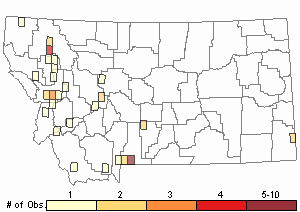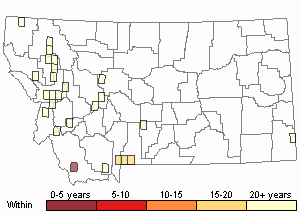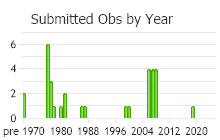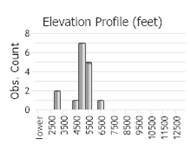View in other NatureServe Network Field Guides
NatureServe
Montana
Utah
Wyoming
Idaho
Wisconsin
British Columbia
South Carolina
Yukon
California
New York
A Cosinodon Moss - Coscinodon calyptratus
Other Names:
Grimmia calyptrata
General Description
Plants: Acrocarpous or cladocarpous. Plants 7-10 mm tall, olivaceous, and in cushions to loose mats.
Leaves: Ovate to ovate-lanceolate; 1.4-2.4 x 0.4-0.7 mm; and not plicate. Margins plane or one margin recurved at mid-leaf. Awn 0.4-1.4 mm.
Leaf Cells: Basal laminal cells near costa are long rectangular, 15-80 x 7-10 µm, & evenly thin-walled. Basal laminal cells near margin quadrate to long-rectangular, 16-60 x 7-15 µm, with lateral walls thin and end walls thick or thin; medial laminal cells 1-layer; distal laminal cells 1-layer.
Diagnostic Characteristics
Characteristics of the sporophyte separate Grimmia and Coscinodon. Coscinodon have calyptra that cover at least half the capsule and are large, bell-shaped, and plicate. Awns are often longer as well. Grimmia have calyptra that are smaller, not plicate, and not bell-shaped.
Range Comments
Confined to western North America, reaching its northern limit in the semi-arid interior of British Columbia and extending southward to southern California and Arizona; predominantly at lower elevations but extending occasionally to subalpine sites (Schofield 1992). Canada: AB, BC; USA: AZ, CA, CO, ID, MN, MT, NV, NM, OR, SD, UT, WA, WI, WY (FNA 2007). In Montana: Madison, Mineral, Missoula, Park, Ravalli, Sanders, and Sweet Grass Counties (Elliott 2016).
Observations in Montana Natural Heritage Program Database
Number of Observations: 48
(Click on the following maps and charts to see full sized version)
Map Help and Descriptions
Relative Density

Recency



 (Observations spanning multiple months or years are excluded from time charts)
(Observations spanning multiple months or years are excluded from time charts)
Habitat
Dry, acidic rocks; sandstone, granitic rock, limestone, and volcanic outcrops. Moderate to high elevations. In western North America it occurs in the mountains of the dry, interior region. It does not occur on the west coast mountains and its eastern boundary is the Rocky Mountain front with “isolated” populations occurring in the Black Hills (SD), WI, and MN.
Reproductive Characteristics
Seta is 1.4-2.4 mm. Capsule is exserted, cylindric, but often constricted at rim; peristome present & solid. Autoicous (FNA 2007).
Stewardship Responsibility
References
- Literature Cited AboveLegend:
 View Online Publication
View Online Publication Elliott, J.C. and A.K. Pipp. 2018. A Checklist of Montana Mosses (1880-2018). Updated 3 January, 2020. Montana Natural Heritage Program, Helena, Montana. 73 pp.
Elliott, J.C. and A.K. Pipp. 2018. A Checklist of Montana Mosses (1880-2018). Updated 3 January, 2020. Montana Natural Heritage Program, Helena, Montana. 73 pp. Flora of North America Editorial Committee, eds. 2007. Flora of North America North of Mexico. Volume 27. Bryophytes: Mosses, Part 1. Oxford University Press, Inc., NY. xxi + 713 pp.
Flora of North America Editorial Committee, eds. 2007. Flora of North America North of Mexico. Volume 27. Bryophytes: Mosses, Part 1. Oxford University Press, Inc., NY. xxi + 713 pp. Schofield, W.B. 1992. Some Common Mosses of British Columbia. Royal British Columbia Museum. Queen's Printer, Canada. 394 pp.
Schofield, W.B. 1992. Some Common Mosses of British Columbia. Royal British Columbia Museum. Queen's Printer, Canada. 394 pp.
- Additional ReferencesLegend:
 View Online Publication
View Online Publication
Do you know of a citation we're missing? Elliot, J. C. 1993. Second checklist of Montana mosses. Unpublished report. U.S. Forest Service, Region 1. Missoula, MT. 45 pp.
Elliot, J. C. 1993. Second checklist of Montana mosses. Unpublished report. U.S. Forest Service, Region 1. Missoula, MT. 45 pp. Flowers, S. 1973. Mosses: Utah and the West. Brigham Young University, Provo, Utah. 567 p.
Flowers, S. 1973. Mosses: Utah and the West. Brigham Young University, Provo, Utah. 567 p. Lawton, E. 1971. Keys for the Identification of the Mosses on the Pacific Northwest. Reprinted from 'Moss Flora of the Pacific Northwest'. Published as Supplement No. 2 of the Journal of the Hattori Botanical Laboratory. Nichinan, Miyazaki, Japan. 66 pp.
Lawton, E. 1971. Keys for the Identification of the Mosses on the Pacific Northwest. Reprinted from 'Moss Flora of the Pacific Northwest'. Published as Supplement No. 2 of the Journal of the Hattori Botanical Laboratory. Nichinan, Miyazaki, Japan. 66 pp. Lawton, E. 1971. Moss Flora of the Pacific Northwest. Hattori Botanical Laboratory. Japan: Yamabuki-cho, Shinjuku-ku, Tokyo. 362 pages plus appendices.
Lawton, E. 1971. Moss Flora of the Pacific Northwest. Hattori Botanical Laboratory. Japan: Yamabuki-cho, Shinjuku-ku, Tokyo. 362 pages plus appendices.
- Web Search Engines for Articles on "A Cosinodon Moss"





